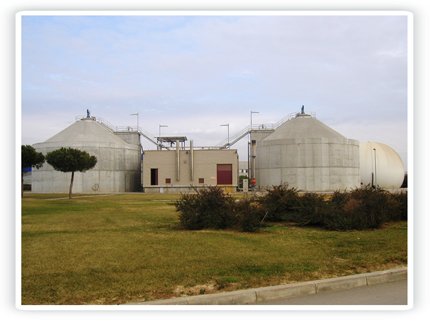
In both solid and liquid waste treatment plants (biomethanization plants) and wastewater treatment plants, a gas is produced that is a mixture of methane, carbon dioxide, and other impurities, called biogas. Since the methane content of biogas is around 50-70%, and it cannot be released into the atmosphere due to its high contaminating potential (it is one of the main greenhouse gases), its high calorific value makes it interesting to utilize for producing electrical energy (cogeneration). Thus, the production and reuse of biogas allow these types of facilities to become increasingly energy self-sufficient.
However, one of the biggest obstacles to using biogas for electricity generation is the nature of the impurities that accompany it. Hydrogen sulfide (H2S) is one of the substances that most frequently and abundantly contaminates biogas. It is a corrosive compound that attacks both the civil works of the facilities where it is produced and the equipment responsible for generating electrical energy. Its concentration in biogas can vary between 1,000 and 20,000 ppmv (parts per million by volume), while for it to be used in cogeneration systems, it cannot contain H2S concentrations higher than about 400 or 500 ppmv.
The desulfurization techniques used to date are based on the chemical oxidation of hydrogen sulfide in washing towers (scrubbers) connected in series. In the first stage, an acidic solution (H2SO4) is used for neutralization, and subsequently, in the second stage, chemical oxidation occurs using an alkaline solution of NaClO and NaOH. This option entails high reagent consumption and presents technical difficulties due to the presence of other chemical species (carbonation of CO2).
The alternative to the traditional solution is the removal of H2S through a fully biological process. Percolating filters are used, where a biofilm composed of sulfur-oxidizing bacteria forms on the surface of the filter’s filling material, that is, microorganisms specialized in the oxidation of reduced sulfur compounds, from which they obtain the energy necessary for their growth. These bioreactors allow for the removal of H2S at an extremely low operating cost, without the use of chemical reagents (economic, safety, and environmental advantages), and offer high and sustained removal efficiency. Although the process is biological, these systems have proven to be very stable, operating for long periods and adapting to the variability of the contaminant load to be degraded. For the start-up of the percolating biofilter, the most effective and simplest option is to inoculate it with a mixed liquor from the biological reactor of an urban wastewater treatment plant. Within a relatively short period, a selection of microorganisms favoring sulfur-oxidizers occurs, and a high removal efficiency can be achieved within a week of inoculation, always depending on the loads to be treated.
The investment costs of a biological desulfurization process compared to the chemical system are slightly lower in favor of the former. However, where the difference is very notable is in the operating costs, as no chemical reagents are used and hardly any waste is produced. This factor makes it economically viable to convert traditional chemical systems into biological ones.